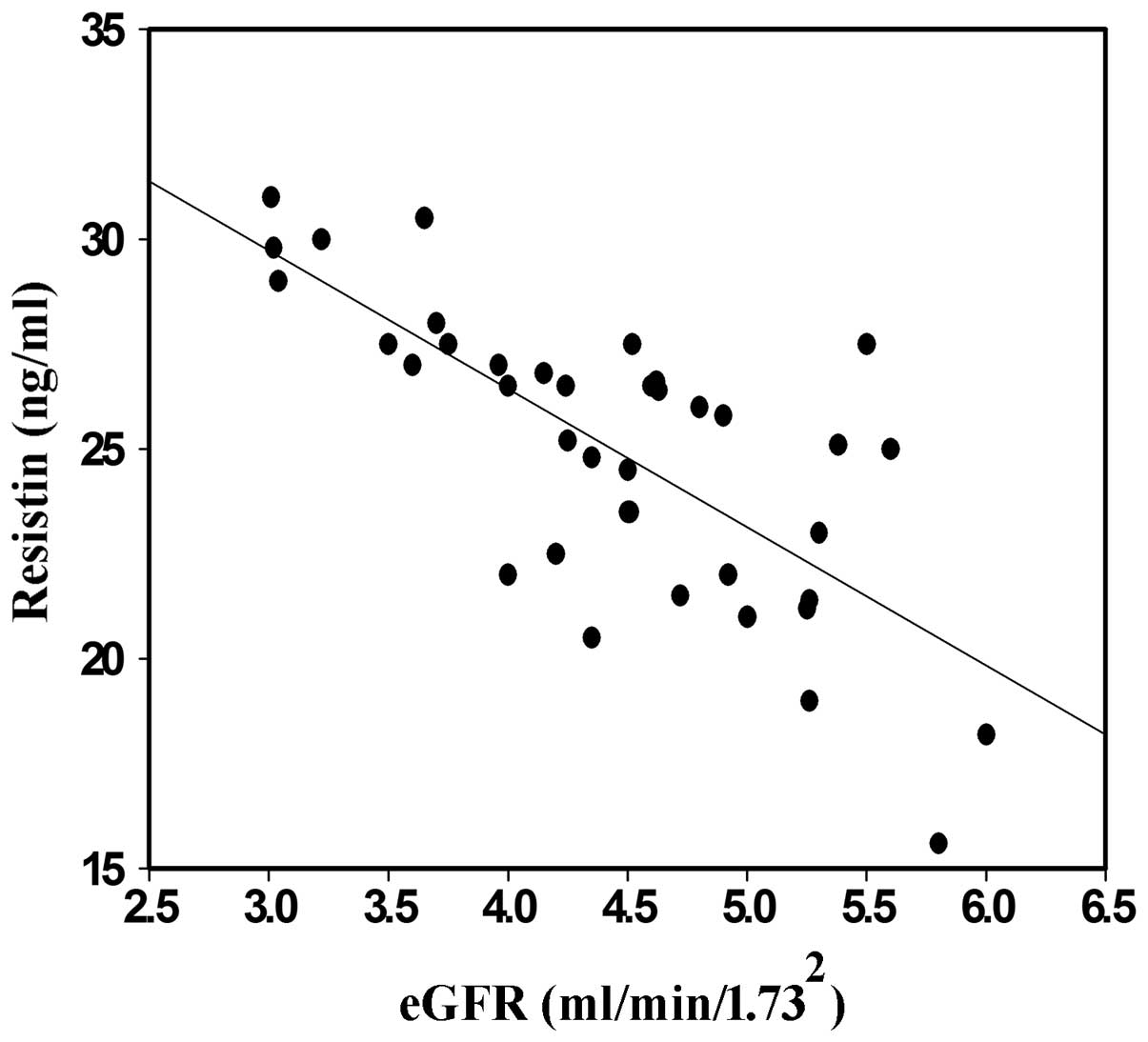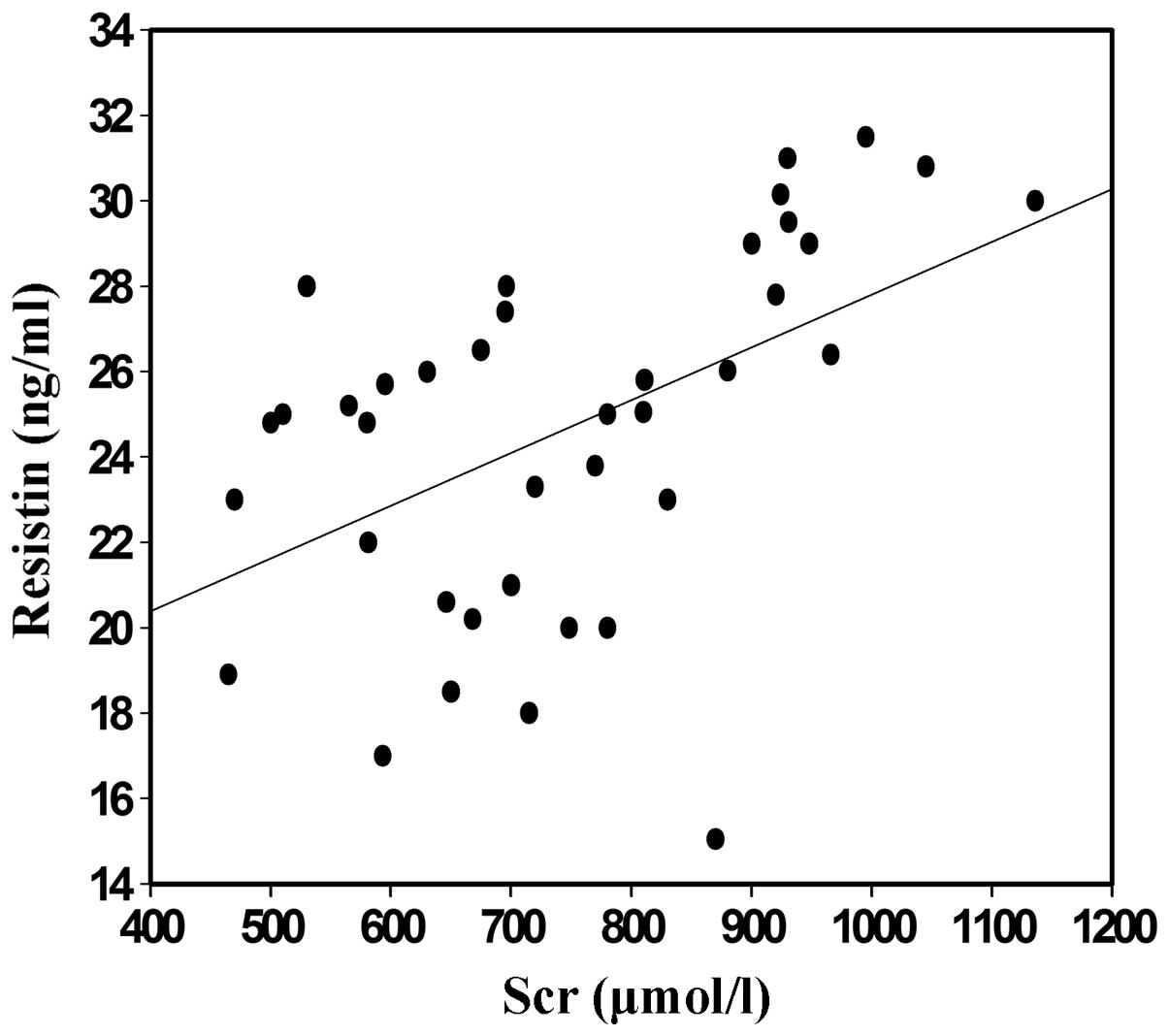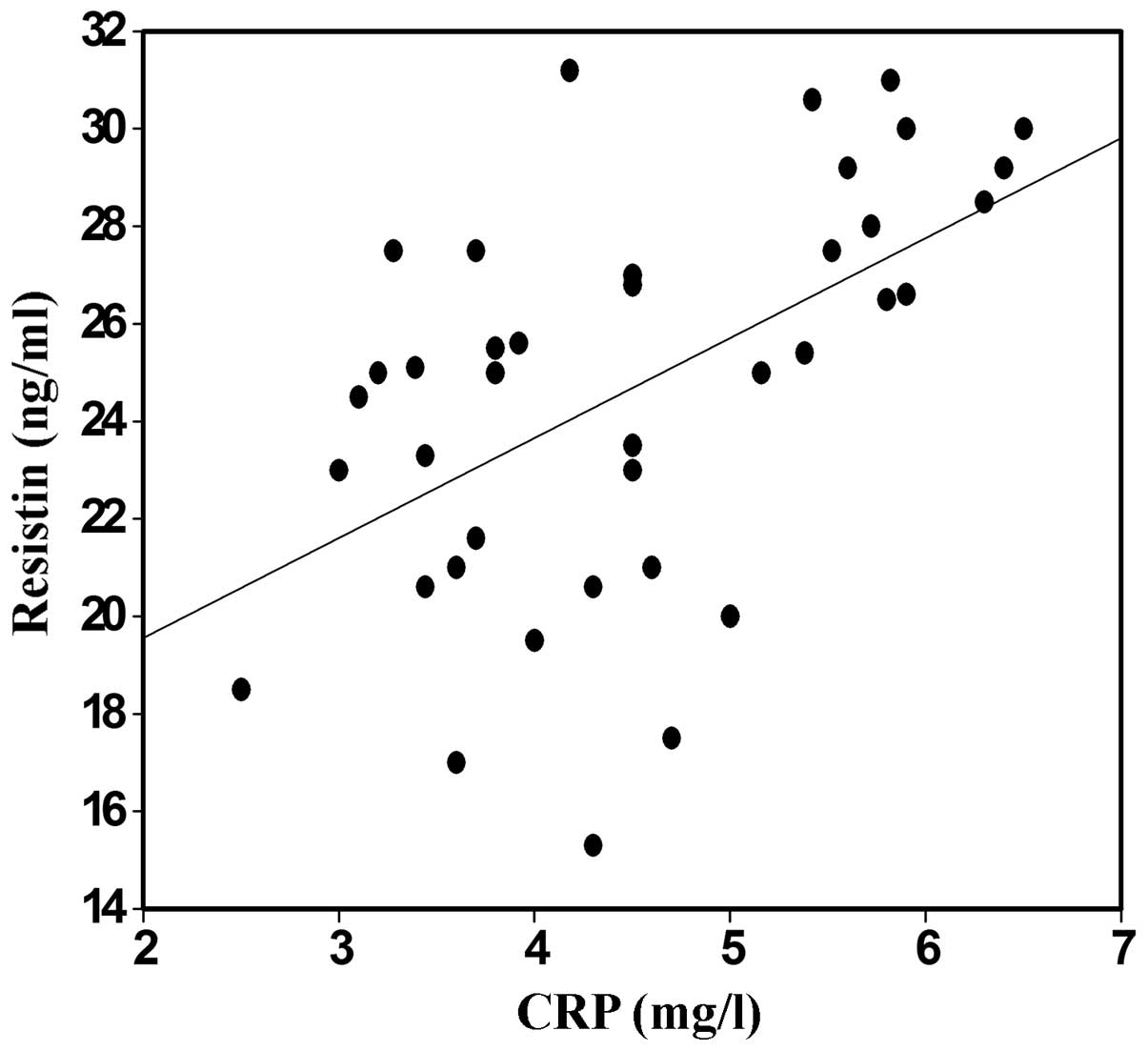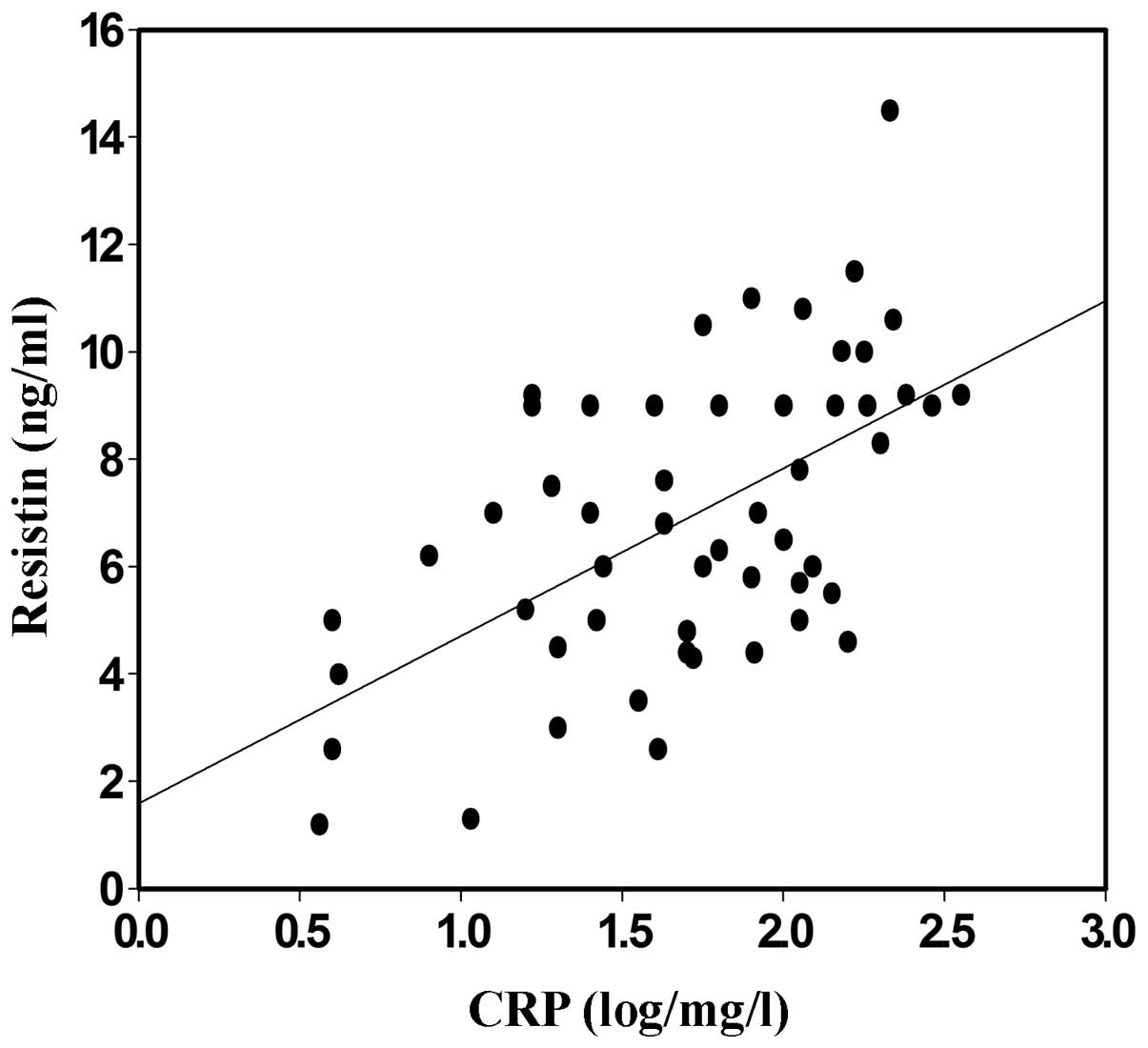|
1
|
Ota T: Chemokine systems link obesity to
insulin resistance. Diabetes Metab J. 37:165–172. 2013. View Article : Google Scholar : PubMed/NCBI
|
|
2
|
Boyraz M, Cekmez F, Karaoğlu A, Cinaz P,
Durak M and Bideci A: Relationship of adipokines (adiponectin,
resistin and RBP4) with metabolic syndrome components in pubertal
obese children. Biomark Med. 7:423–428. 2013. View Article : Google Scholar : PubMed/NCBI
|
|
3
|
Chen XY, Zhang JH, Liu F, Liu HM, Song YY
and Liu YL: Association of serum resistin levels with metabolic
syndrome and early atherosclerosis in obese Chinese children. J
Pediatr Endocrinol Metab. 26:855–860. 2013. View Article : Google Scholar : PubMed/NCBI
|
|
4
|
Drouet L, Bal Dit and Sollier C:
Fibrinogen: factor and marker of cardiovascular risk. J Mal Vasc.
27:143–156. 2002.(In French). PubMed/NCBI
|
|
5
|
Kim KH, Lee K, Moon YS and Sul HS: A
cysteine-rich adipose tissue-specific secretory factor inhibits
adipocyte differentiation. J Biol Chem. 276:11252–11256. 2001.
View Article : Google Scholar : PubMed/NCBI
|
|
6
|
Imai E, Horio M, Nitta K, et al:
Modification of the Modification of Diet in Renal Disease (MDRD)
Study equation for Japan. Am J Kidney Dis. 50:927–937. 2007.
View Article : Google Scholar : PubMed/NCBI
|
|
7
|
Steppan CM, Bailey ST, Bhat S, et al: The
hormone resistin links obesity to diabetes. Nature. 409:307–312.
2001. View
Article : Google Scholar : PubMed/NCBI
|
|
8
|
Ren W, Pan H, Wang P, et al: Clinical
analysis of pulmonary infection in hemodialysis patients. Exp Ther
Med. 7:1713–1717. 2014.PubMed/NCBI
|
|
9
|
Díez JJ, Iglesias P, Fernández-Reyes MJ,
et al: Serum concentrations of leptin, adiponectin and resistin,
and their relationship with cardiovascular disease in patients with
end-stage renal disease. Clin Endocrinol (Oxf). 62:242–249. 2005.
View Article : Google Scholar : PubMed/NCBI
|
|
10
|
Briana DD and Malamitsi-Puchner A: The
role of adipocytokines in fetal growth. Ann NY Acad Sci.
1205:82–87. 2010. View Article : Google Scholar : PubMed/NCBI
|
|
11
|
Lago F, Dieguez C, Gómez-Reino J and
Gualillo O: The emerging role of adipokines as mediators of
inflammation and immune responses. Cytokine Growth Factor Rev.
18:313–325. 2007. View Article : Google Scholar : PubMed/NCBI
|
|
12
|
Papaldo P, Ferretti G, Di Cosimo S, et al:
Does granulocyte colony-stimulating factor worsen anemia in early
breast cancer patients treated with epirubicin and
cyclophosphamide? J Clin Oncol. 24:3048–3055. 2006. View Article : Google Scholar : PubMed/NCBI
|
|
13
|
Anderson PD, Mehta NN, Wolfe ML, et al:
Innate immunity modulates adipokines in humans. J Clin Endocrinol
Metab. 92:2272–2279. 2007. View Article : Google Scholar : PubMed/NCBI
|
|
14
|
Borissova AM, Djambazova A, Todorov K,
Dakovska L, Tankova T and Kirilov G: Effect of erythropoietin on
the metabolic state and peripheral insulin sensitivity in diabetic
patients on haemodialysis. Nephrol Dial Transplant.
8:931993.PubMed/NCBI
|
|
15
|
Rasic-Milutinovic Z, Perunicic-Pekovic G,
Cavala A, Gluvic Z, Bokan L and Stankovic S: The effect of
recombinant human erythropoietin treatment on insulin resistance
and inflammatory markers in non-diabetic patients on maintenance
hemodialysis. Hippokratia. 12:157–161. 2008.PubMed/NCBI
|
|
16
|
National Kidney Foundation: K/DOQI
clinical practice guidelines for chronic kidney disease:
evaluation, classification, and stratification. Am J Kidney Dis.
39(2 Suppl 1): S1–S266. 2002.PubMed/NCBI
|
|
17
|
Nüsken KD, Kratzsch J, Wienholz V, Stöhr
W, Rascher W and Dötsch J: Circulating resistin concentrations in
children depend on renal function. Nephrol Dial Transplant.
21:107–112. 2006. View Article : Google Scholar : PubMed/NCBI
|
|
18
|
Ridker PM, Pare G, Parker A, et al: Loci
related to metabolic-syndrome pathways including LEPR, HNF1A, IL6R,
and GCKR associate with plasma C-reactive protein: the Women's
Genome Health Study. Am J Hum Genet. 82:1185–1192. 2008. View Article : Google Scholar : PubMed/NCBI
|
|
19
|
Takeda A, Toda T, Shinohara S, Mogi Y and
Matsui N: Factors contributing to higher hematocrit levels in
hemodialysis patients not receiving recombinant human
erythropoietin. Am J Kidney Dis. 40:104–109. 2002. View Article : Google Scholar : PubMed/NCBI
|
|
20
|
Di Iorio B, Cirillo M, Bellizzi V,
Stellato D and De Santo NG: Campania Dialysis Registry Research
Group: Prevalence and correlates of anemia and uncontrolled anemia
in chronic hemodialysis patients - the Campania Dialysis Registry.
Int J Artif Organs. 30:325–333. 2007.PubMed/NCBI
|
|
21
|
Locatelli F, Andrulli S, Memoli B, et al:
Nutritional-inflammation status and resistance to erythropoietin
therapy in haemodialysis patients. Nephrol Dial Transplant.
21:991–998. 2006. View Article : Google Scholar : PubMed/NCBI
|
|
22
|
Kotanko P, Thijssen S and Levin NW:
Association between erythropoietin responsiveness and body
composition in dialysis patients. Blood Purif. 26:82–89. 2008.
View Article : Google Scholar : PubMed/NCBI
|


















